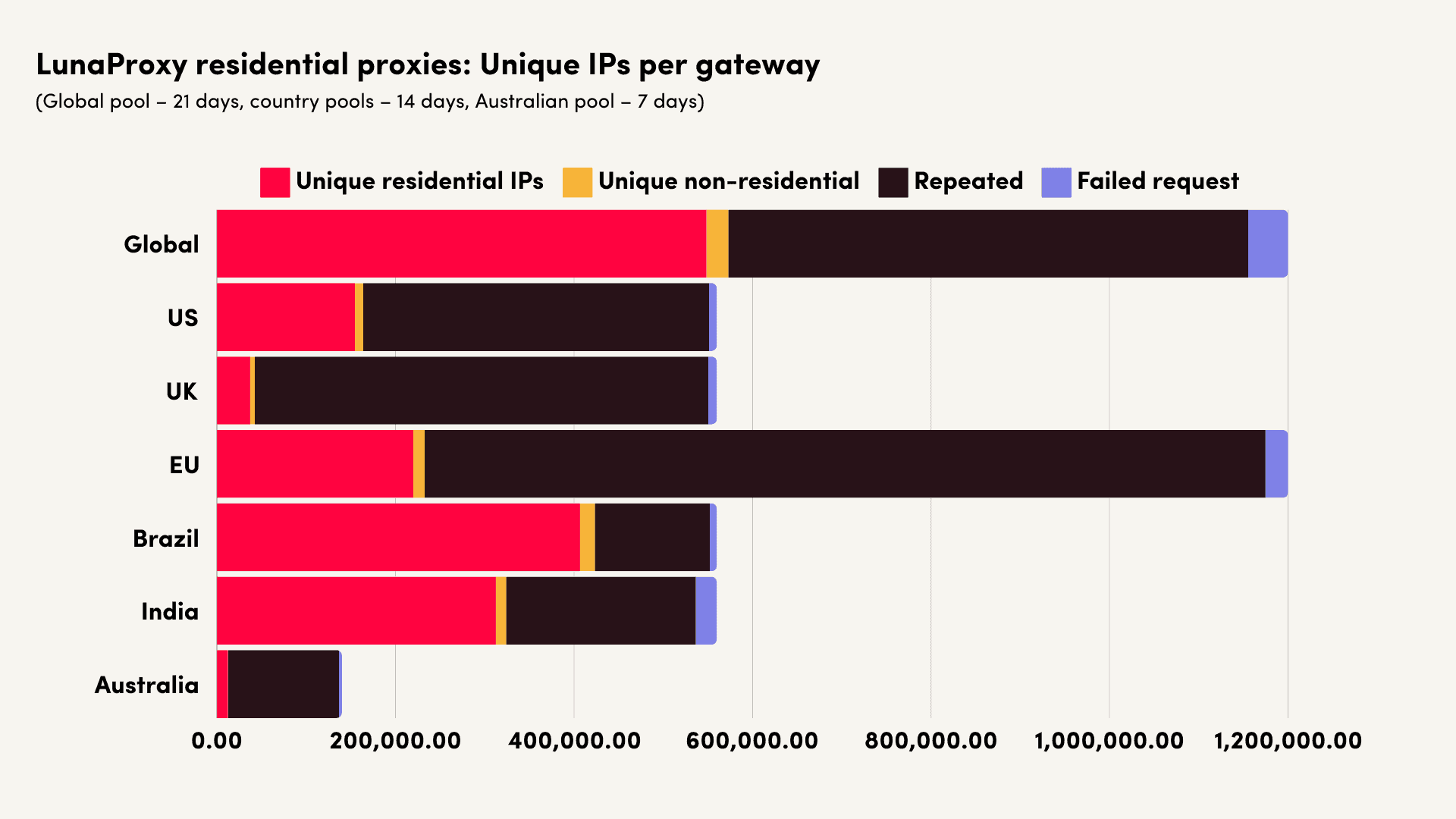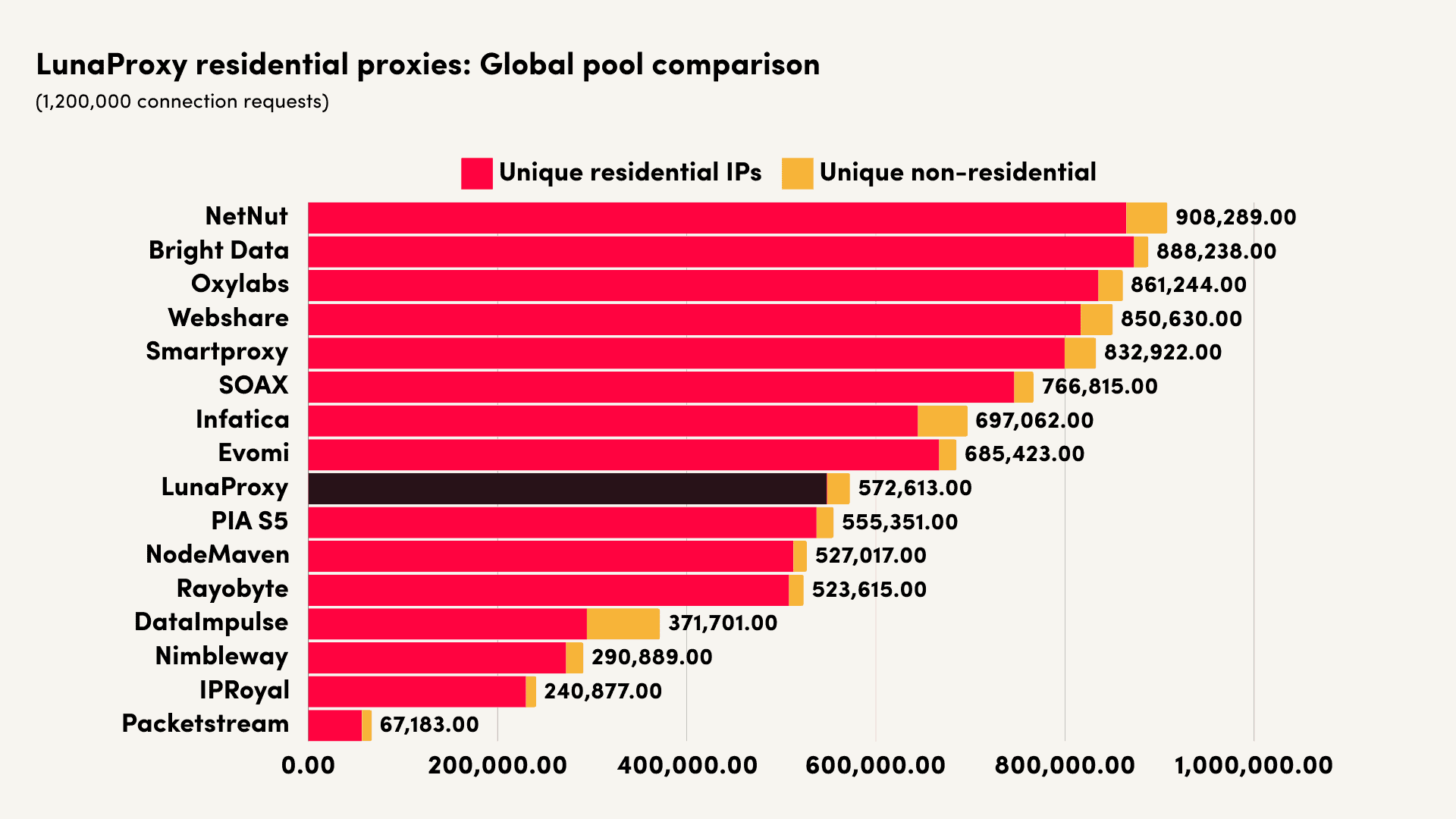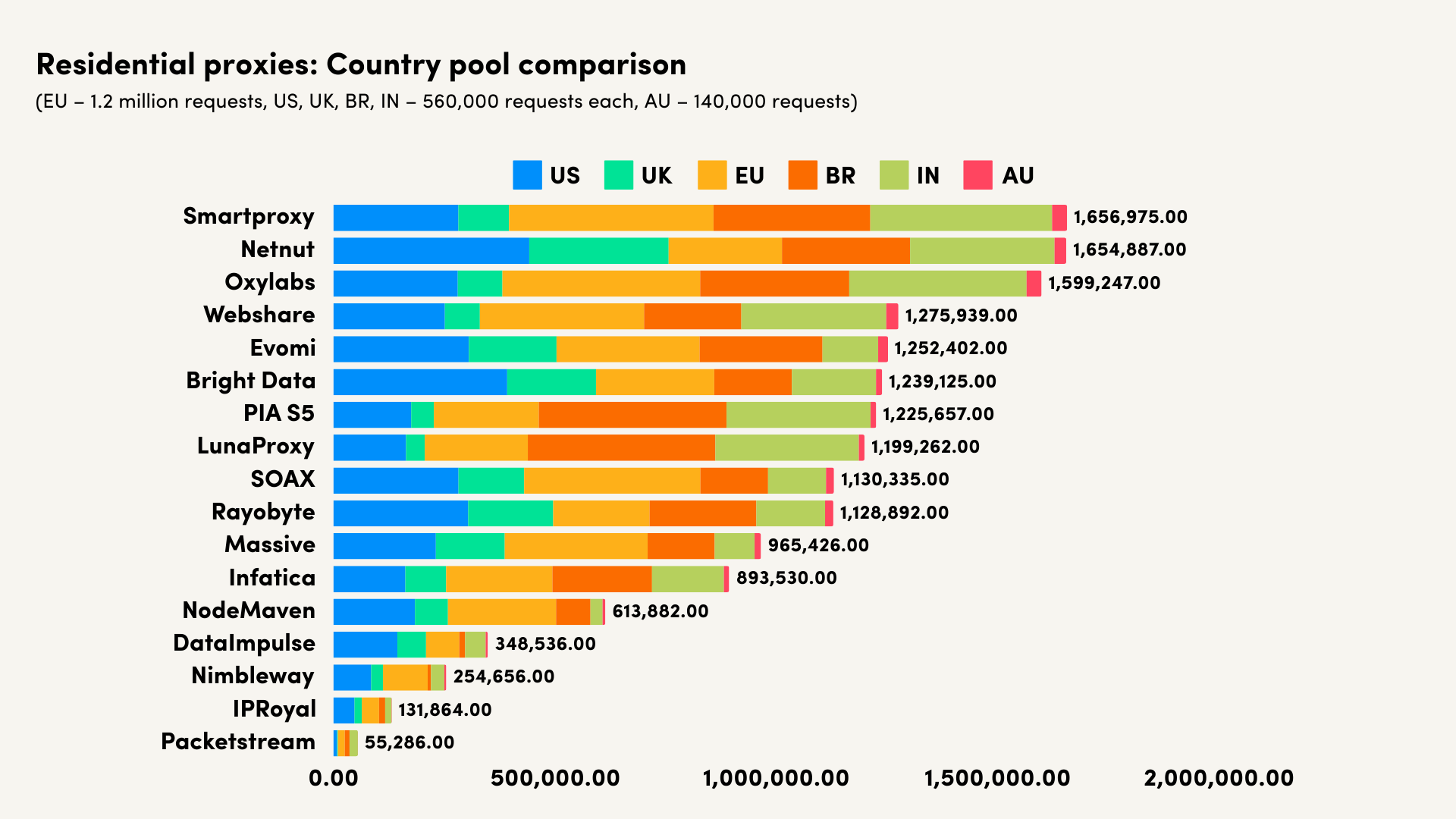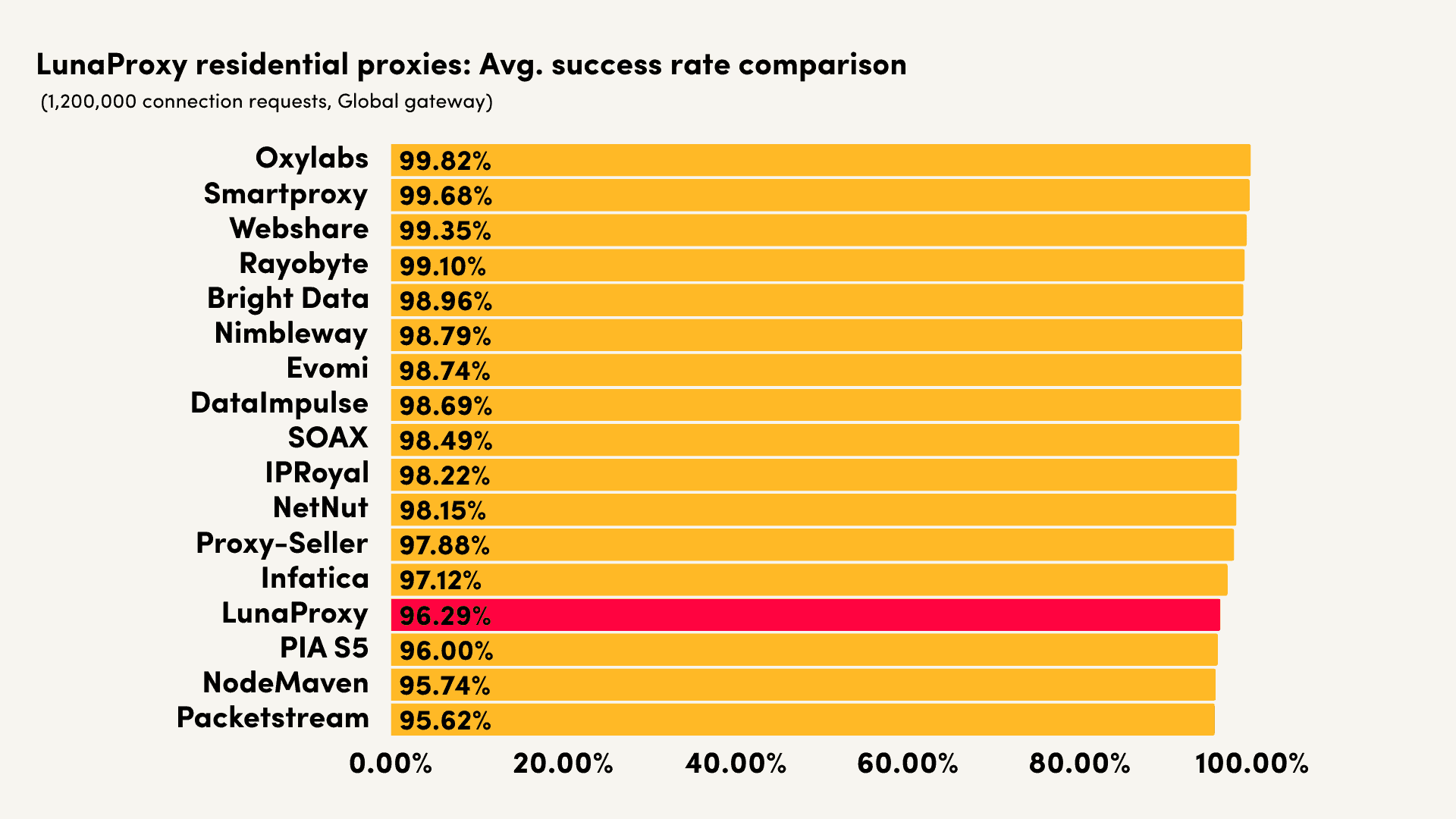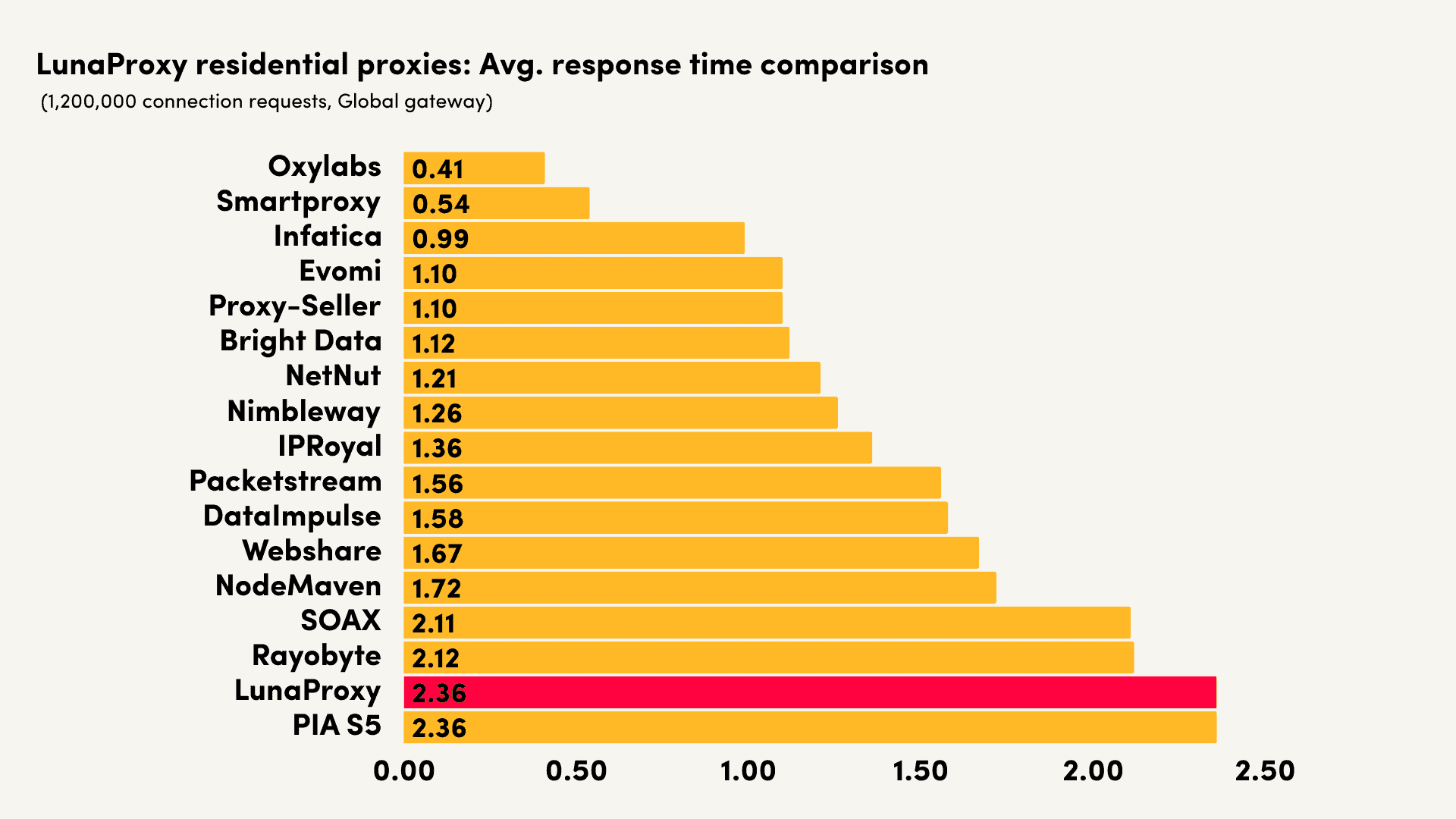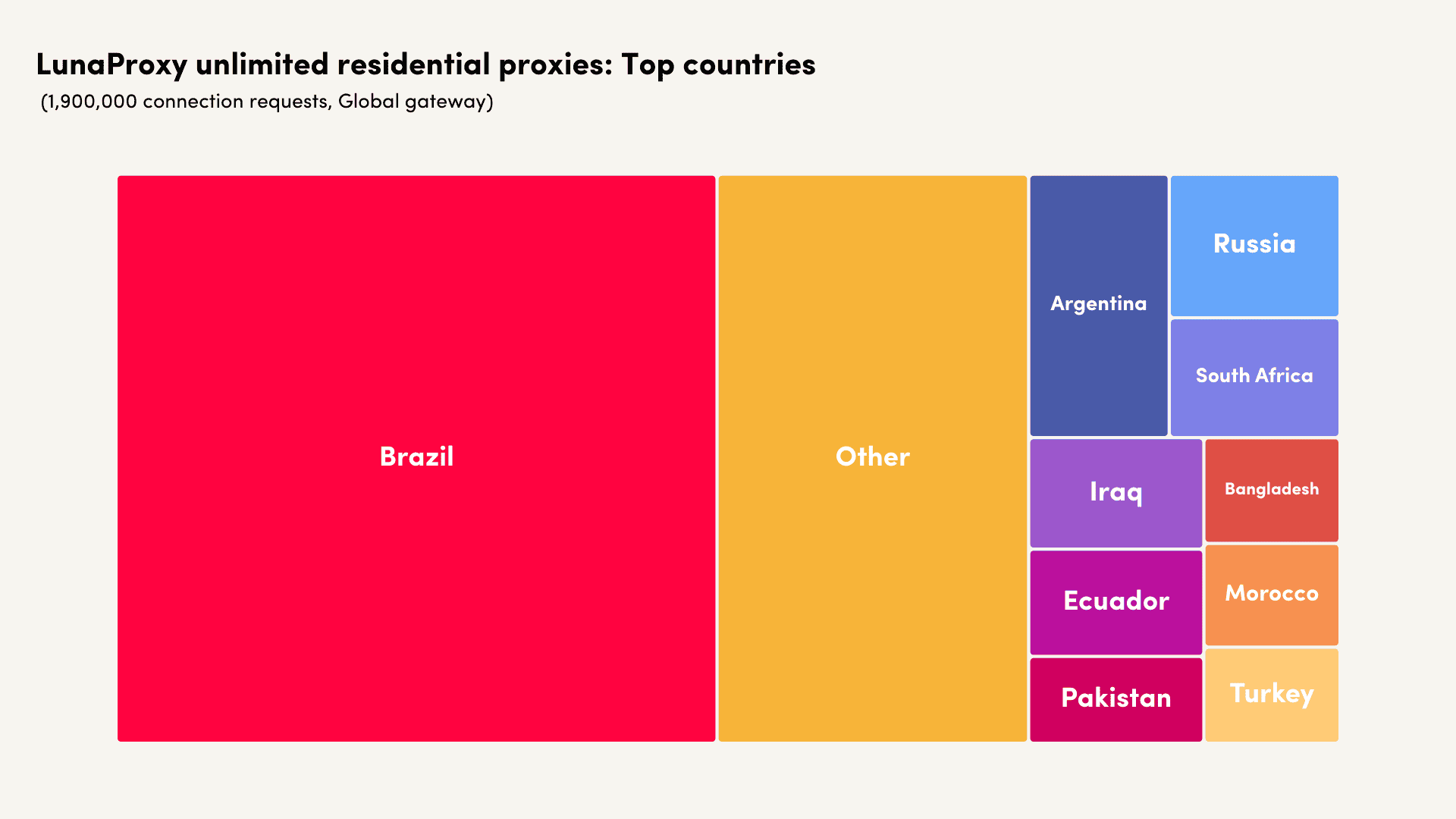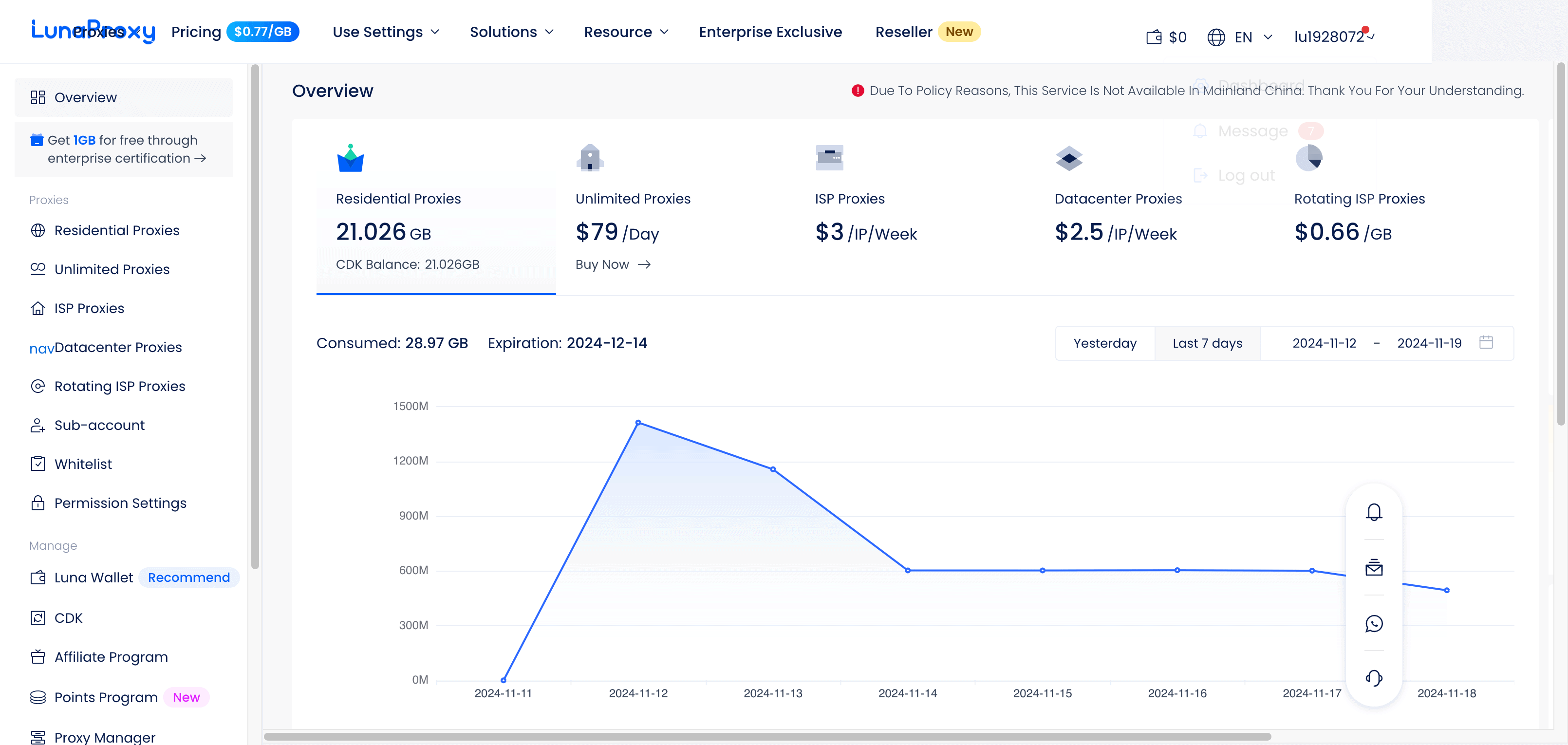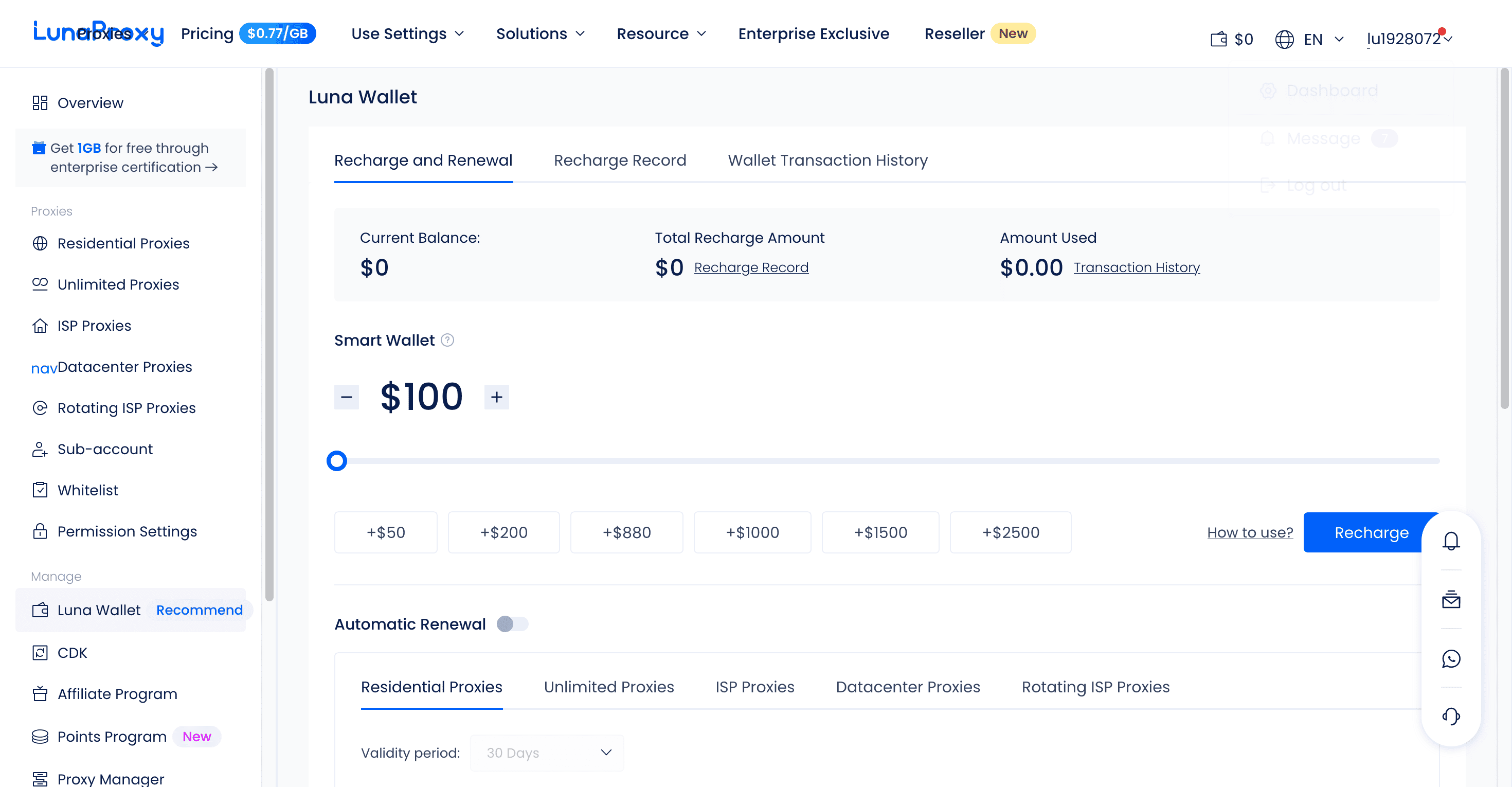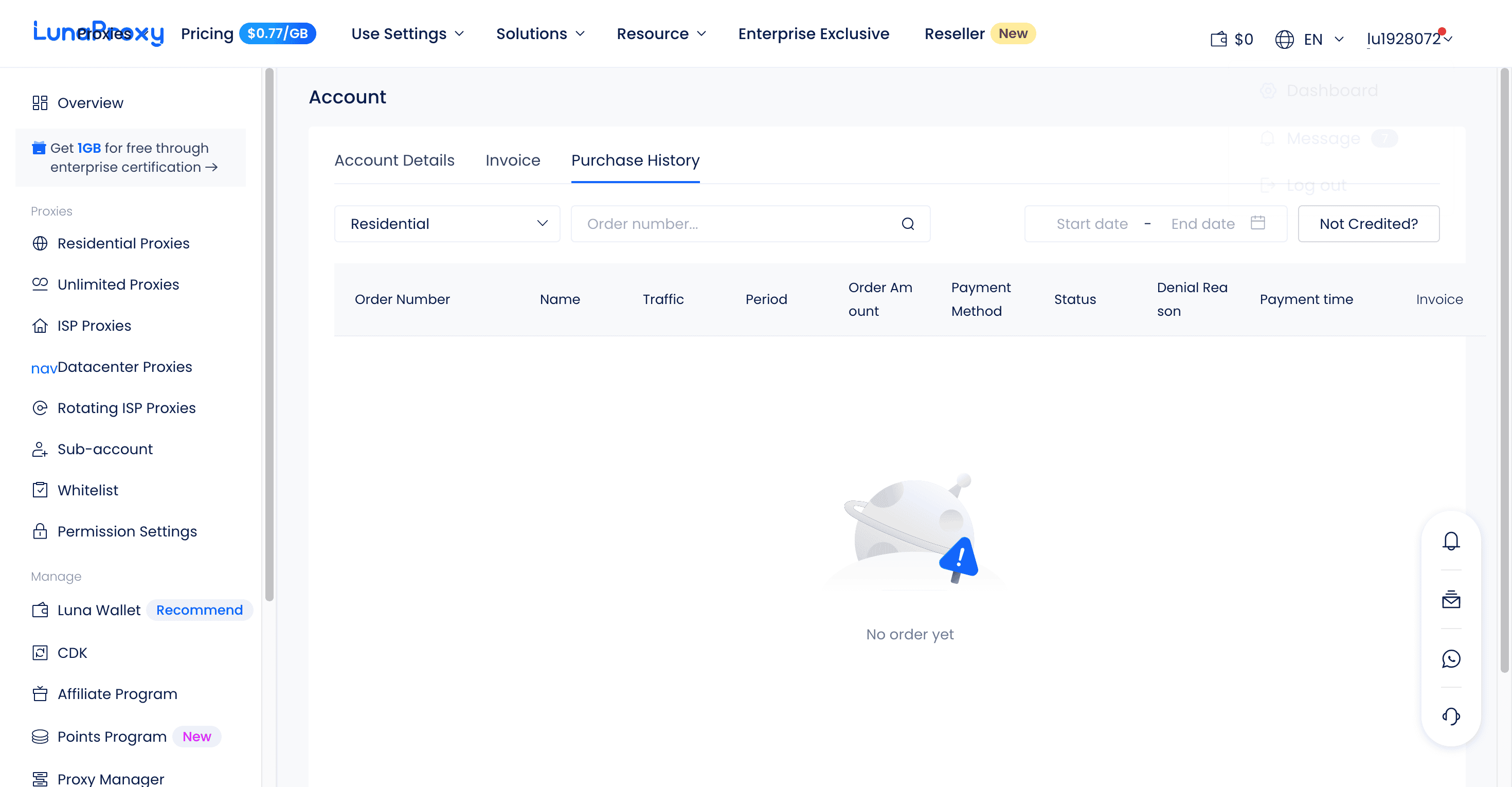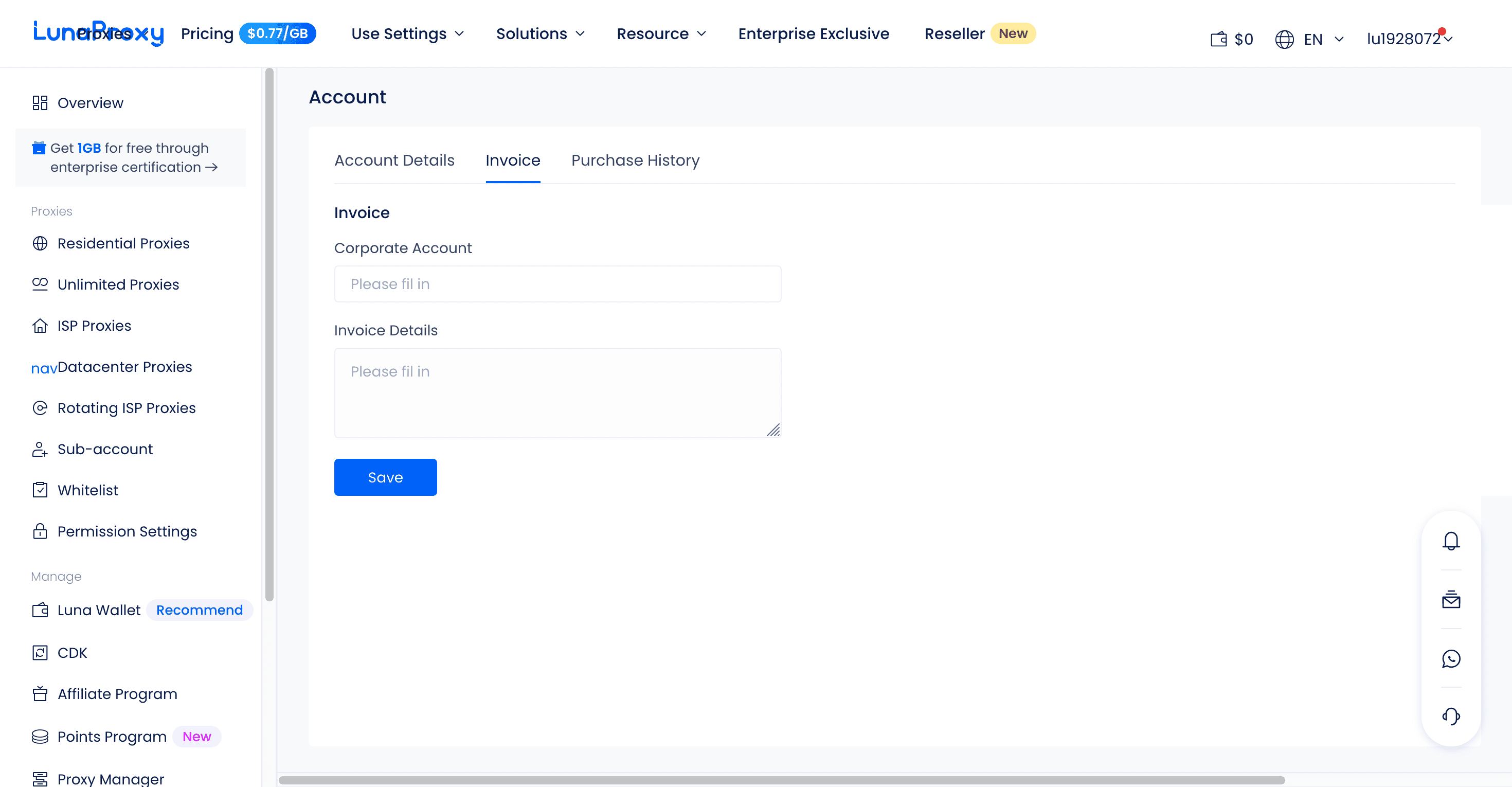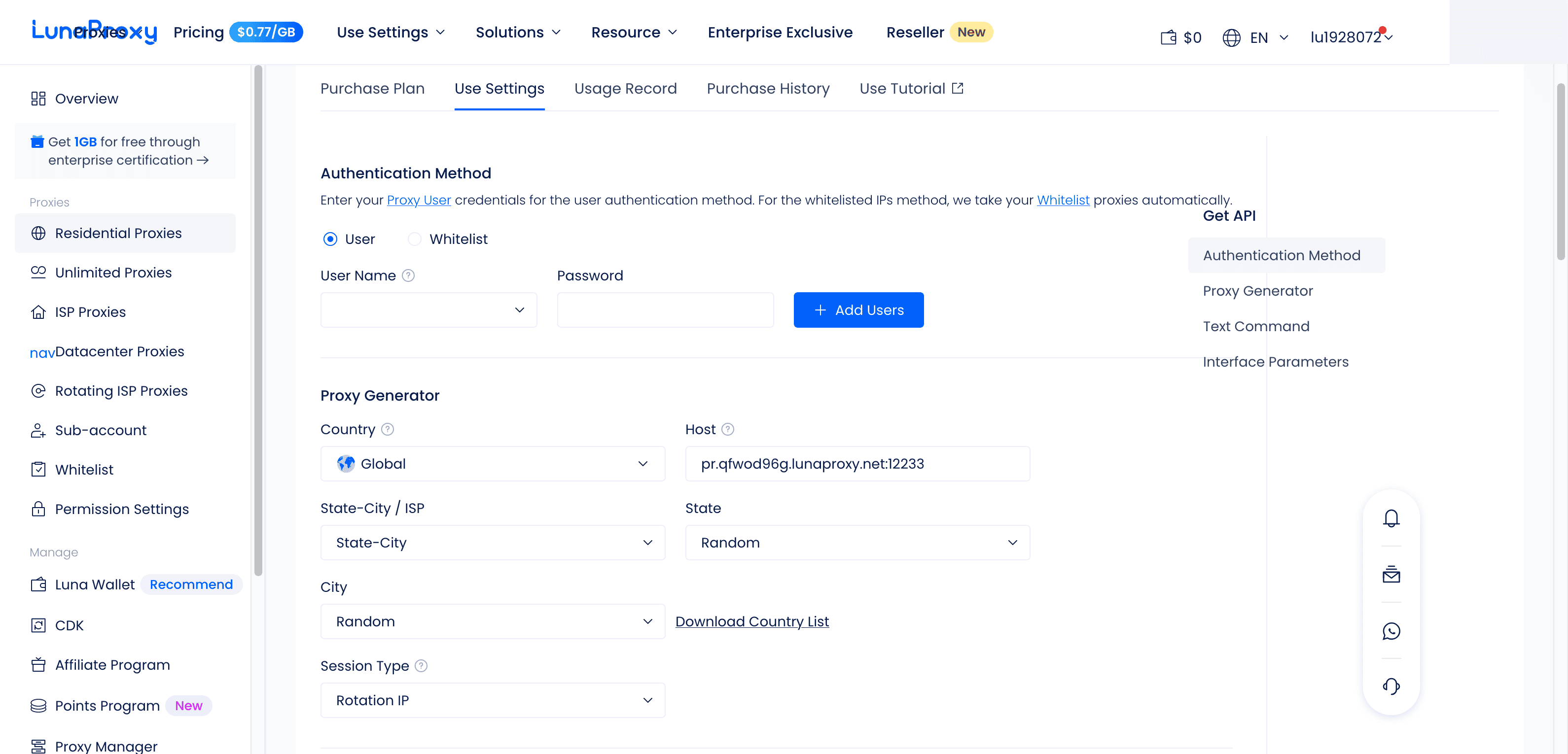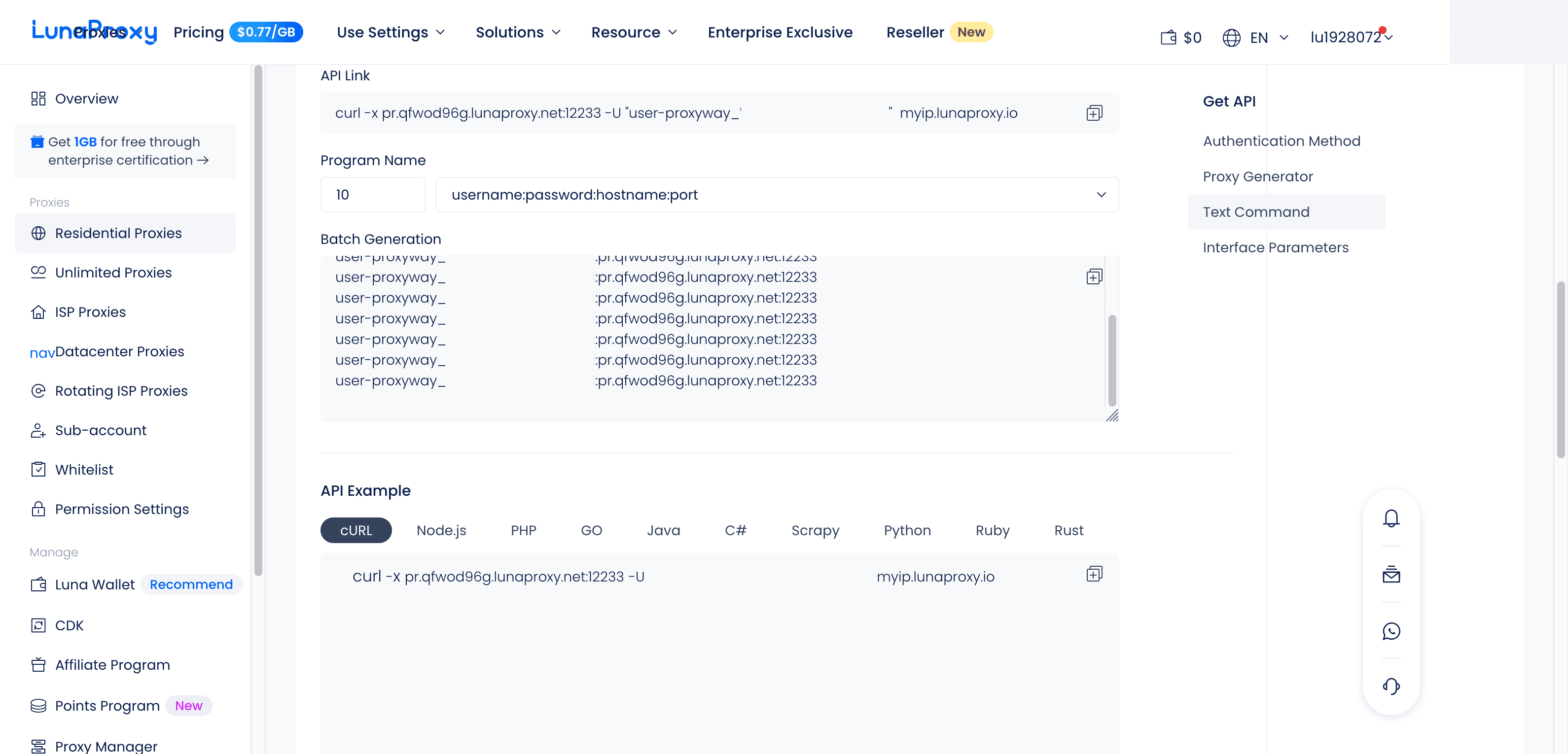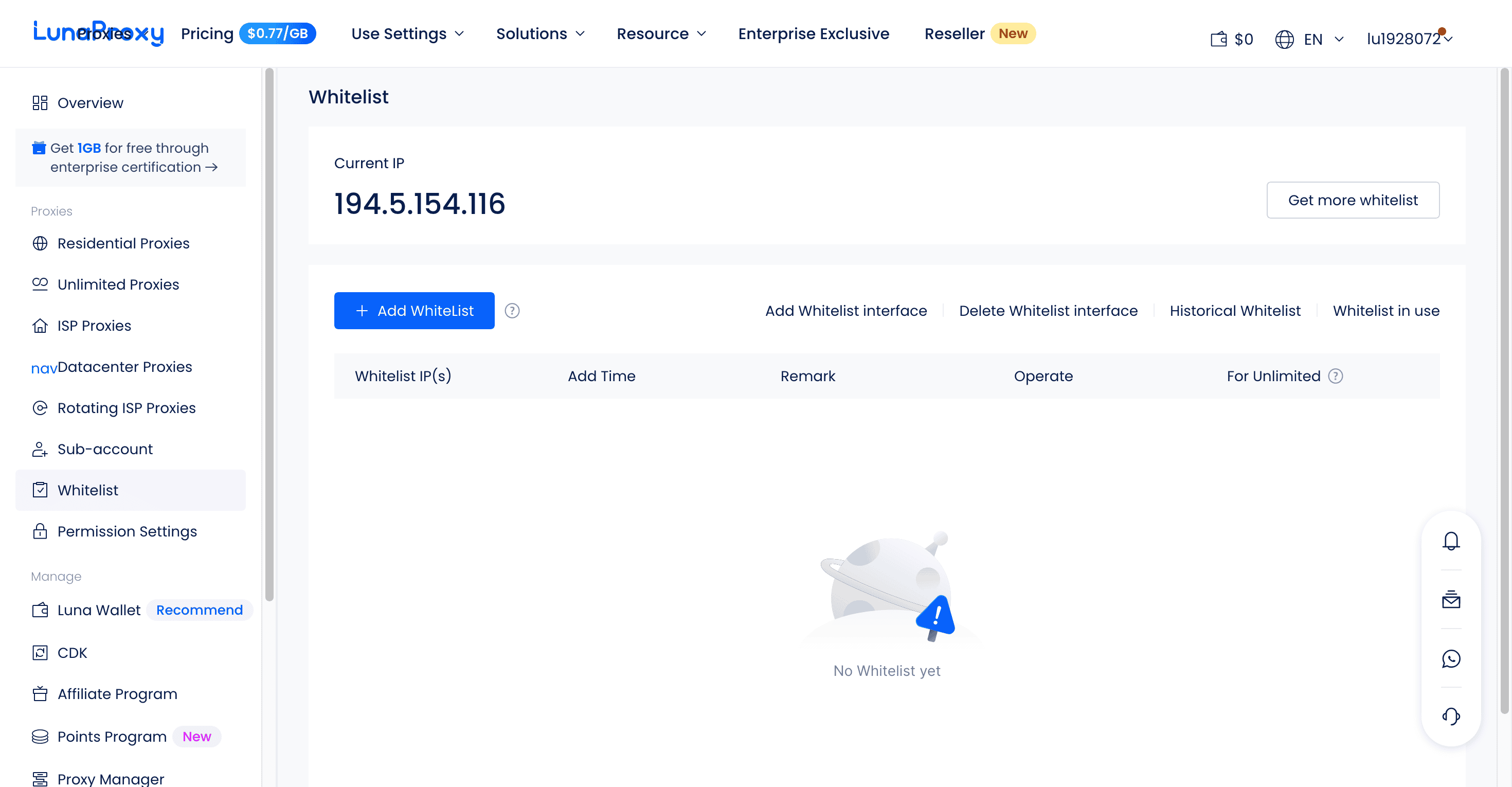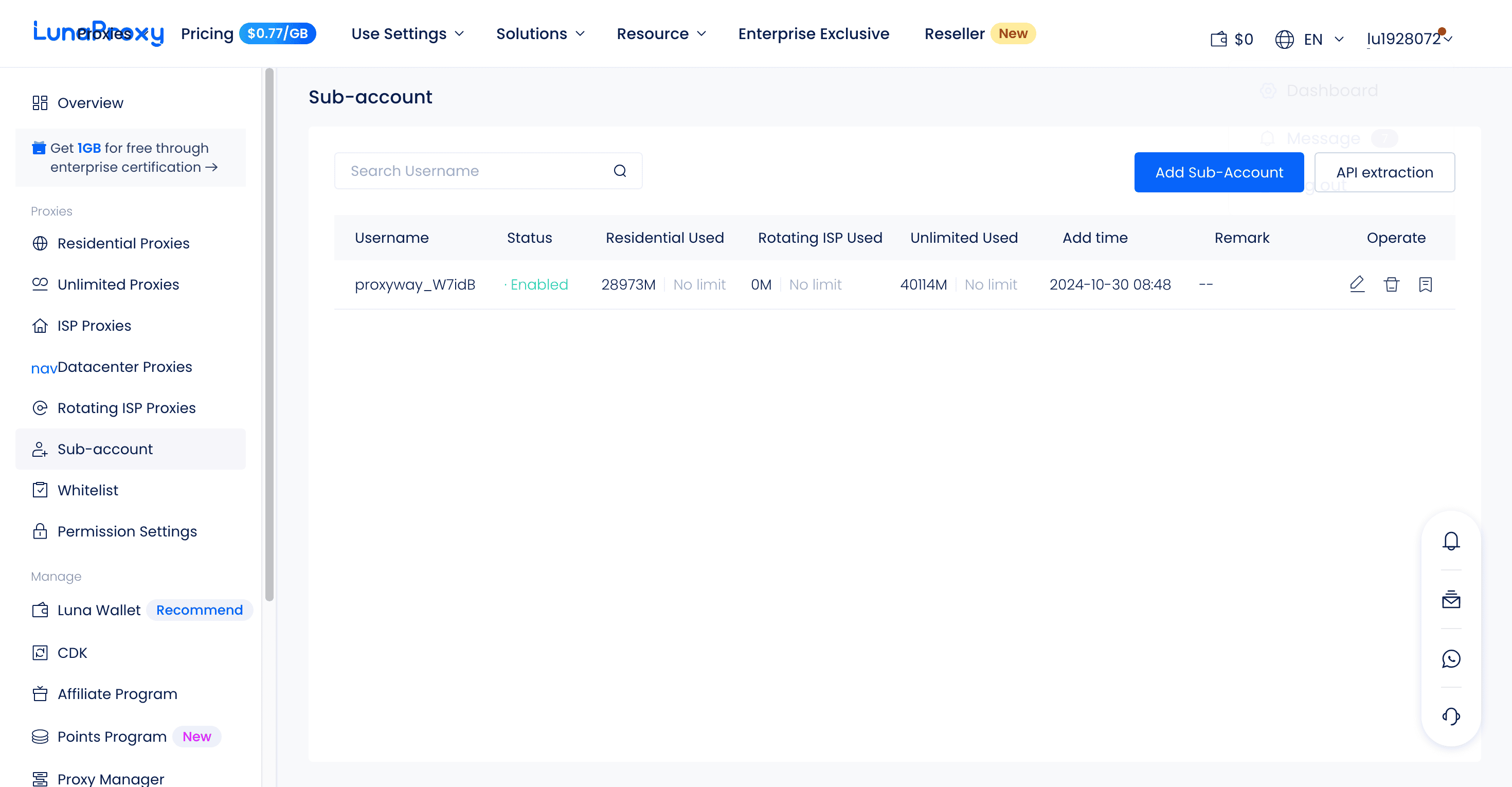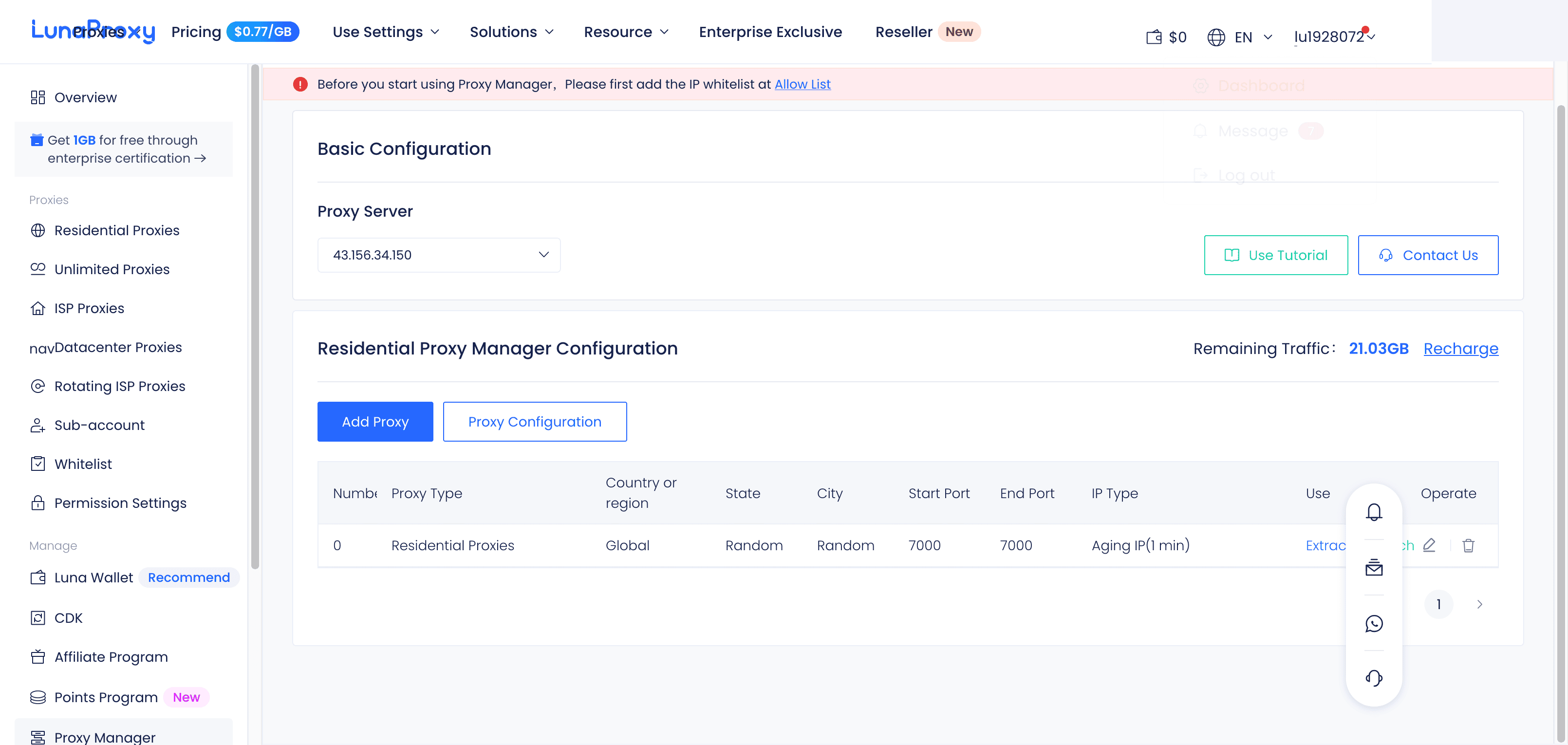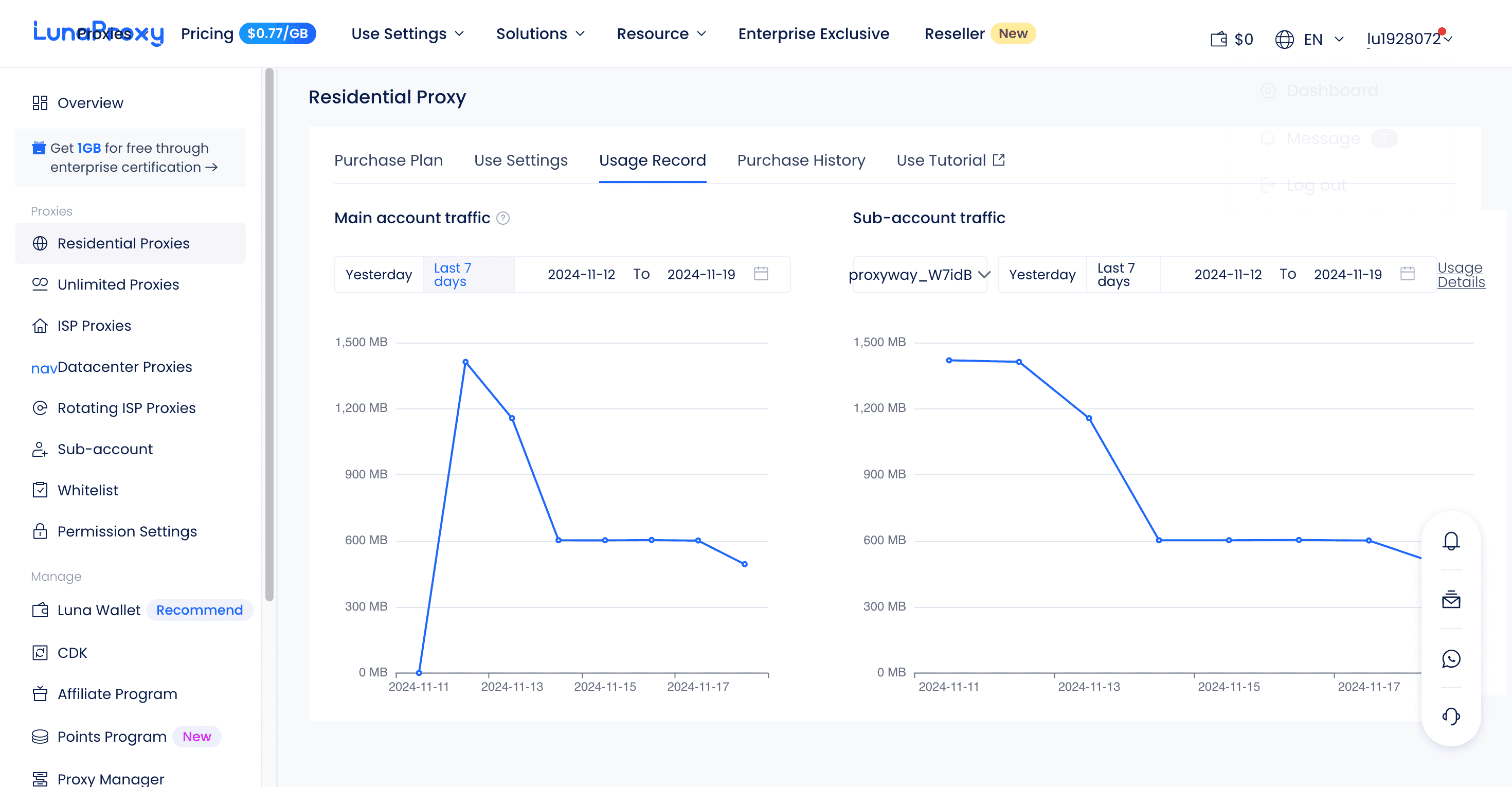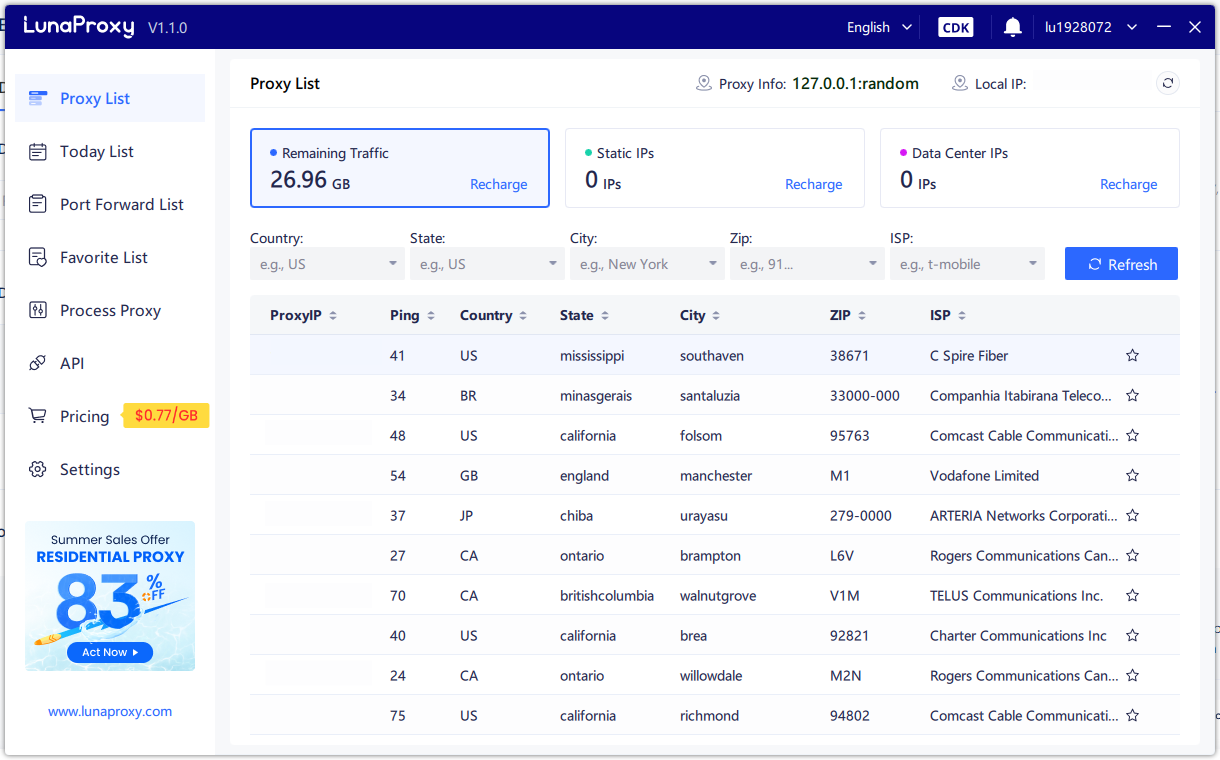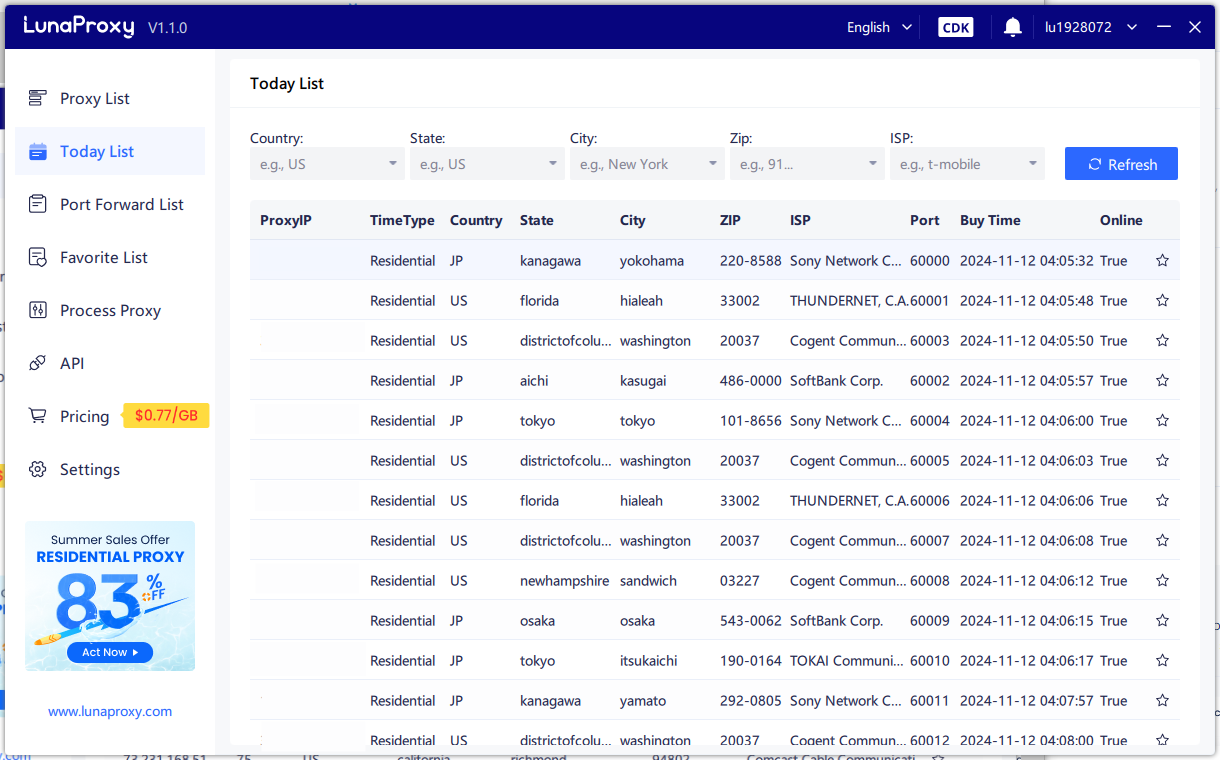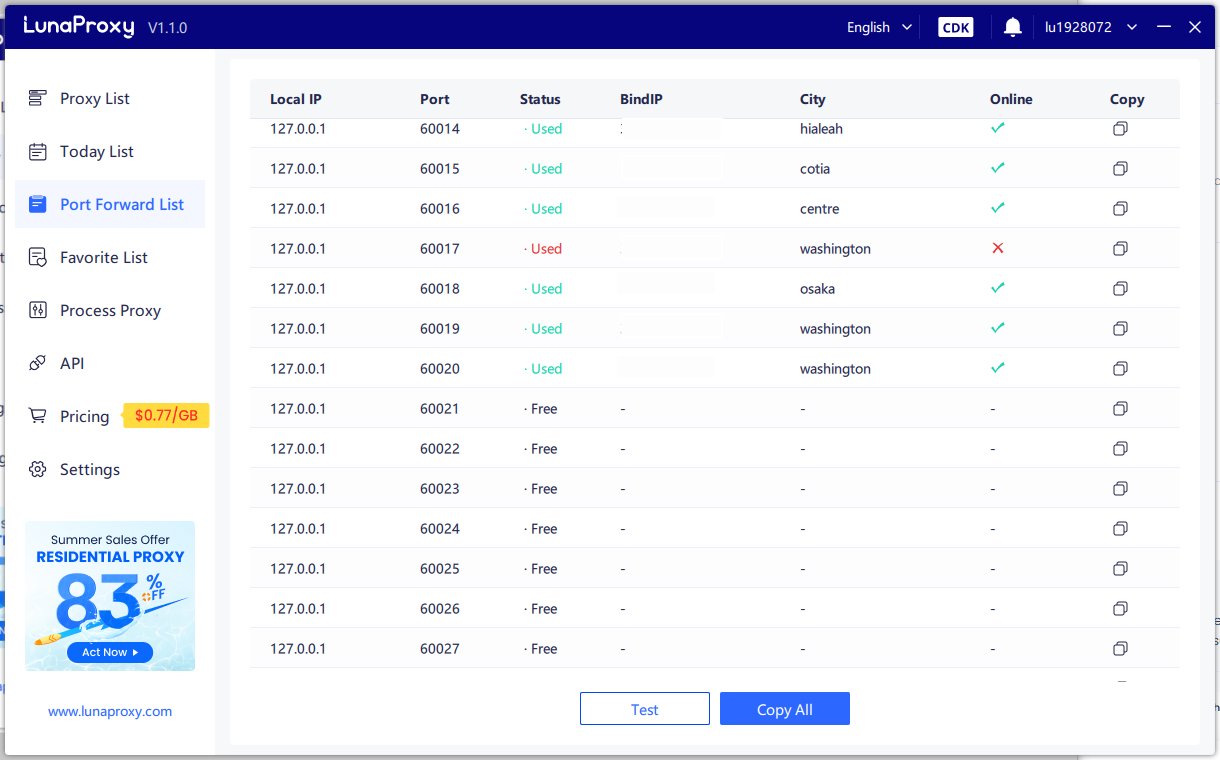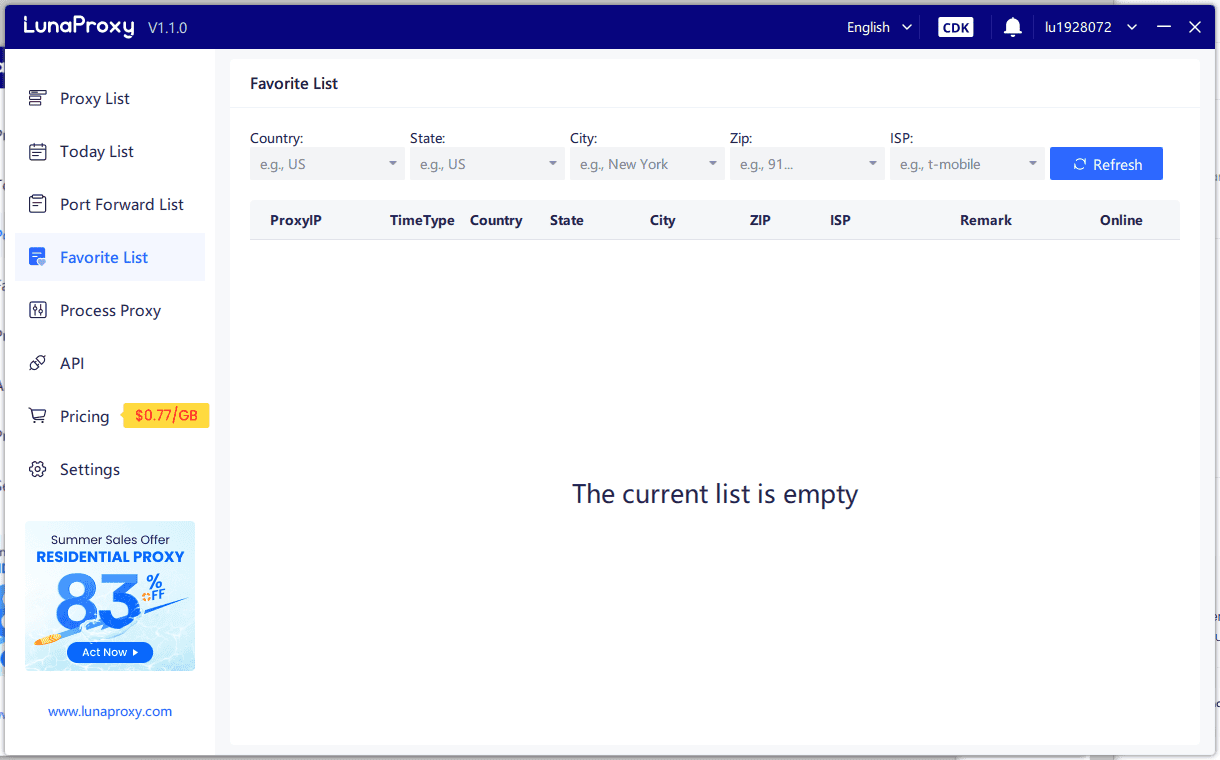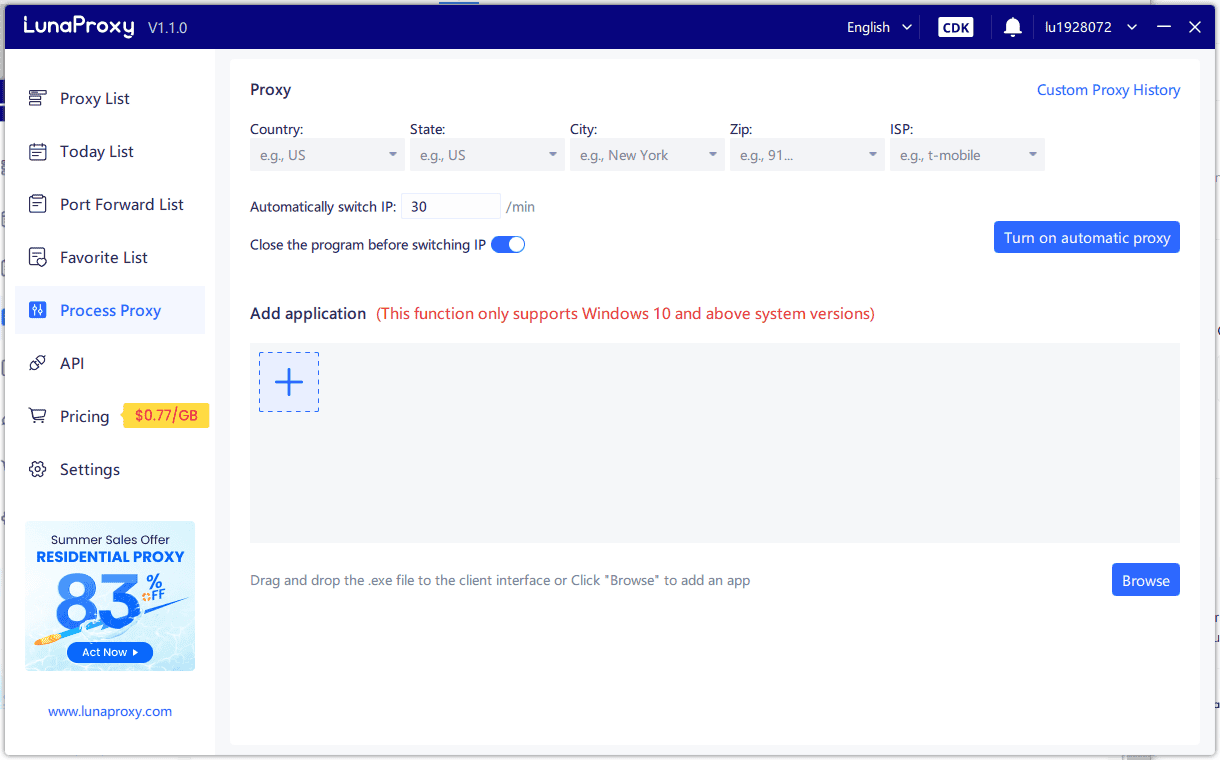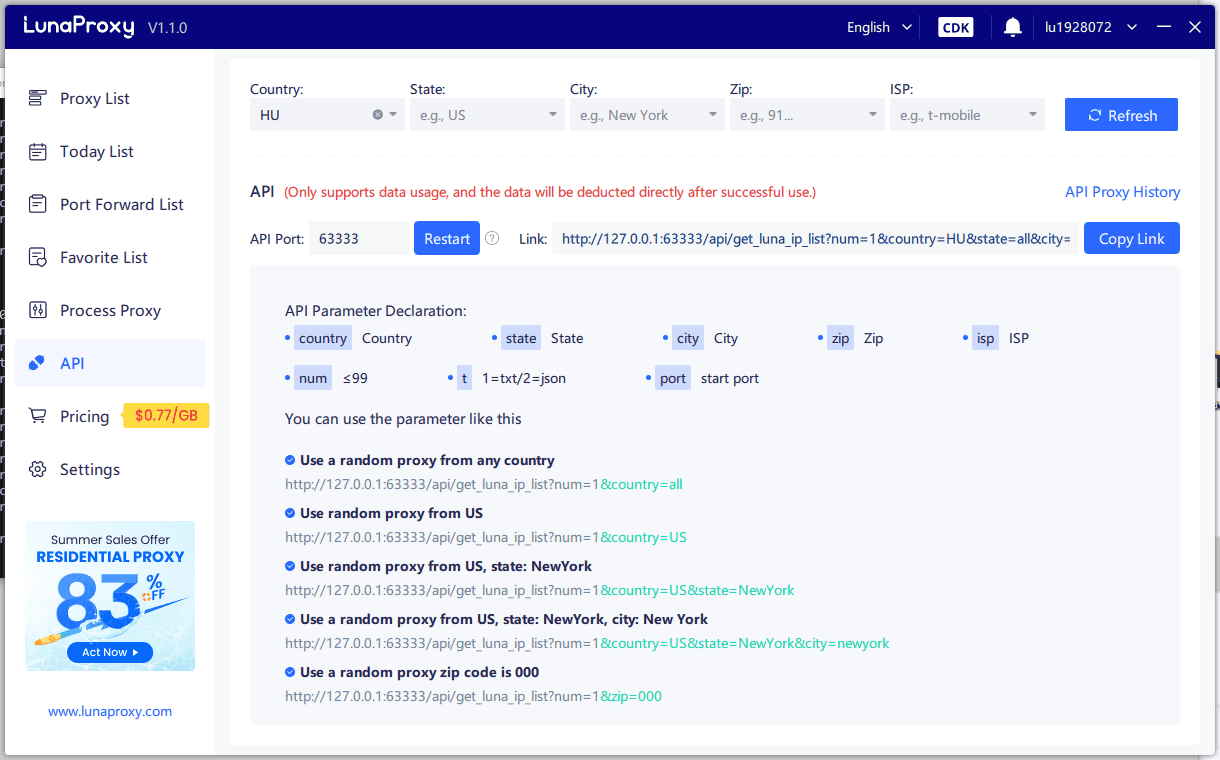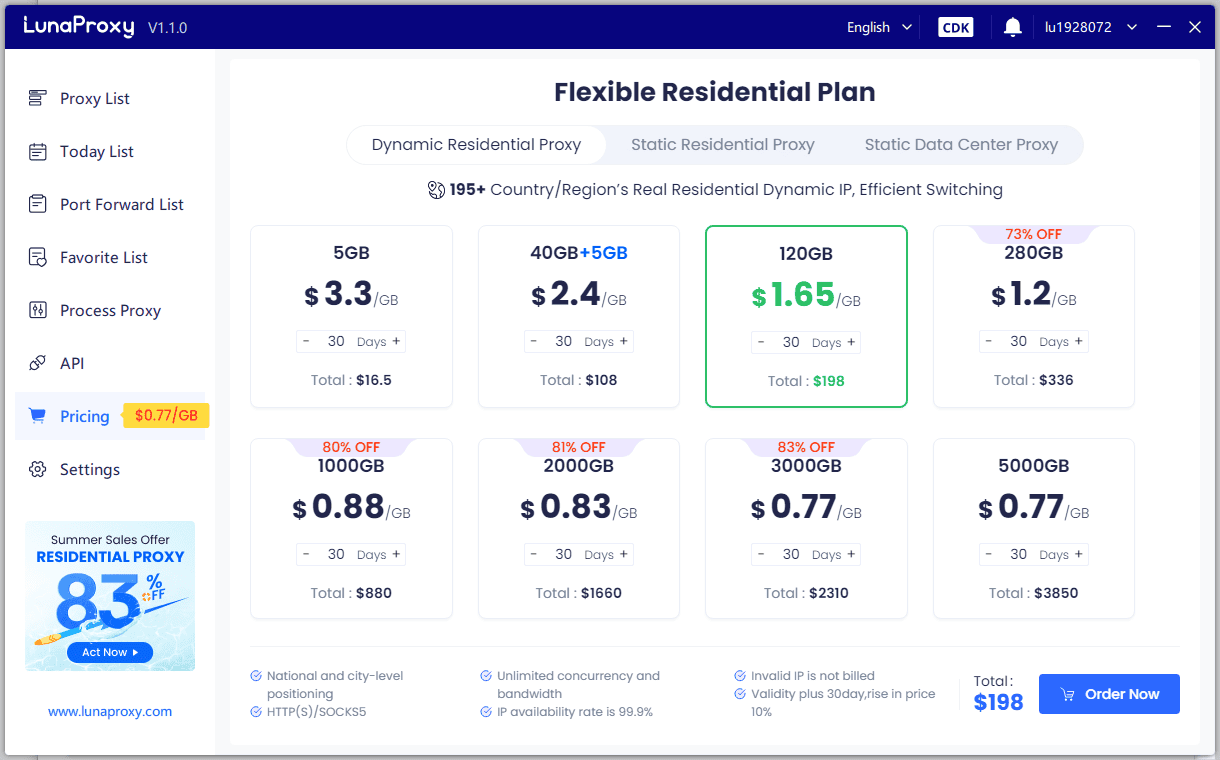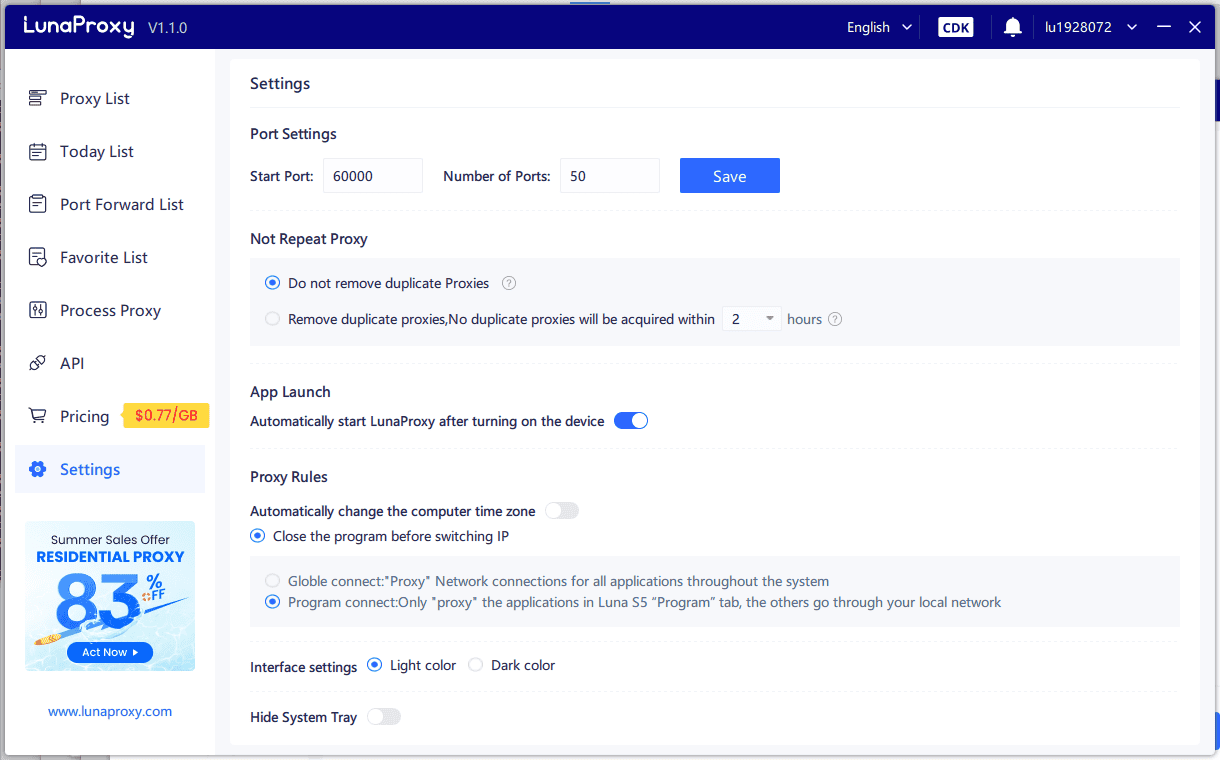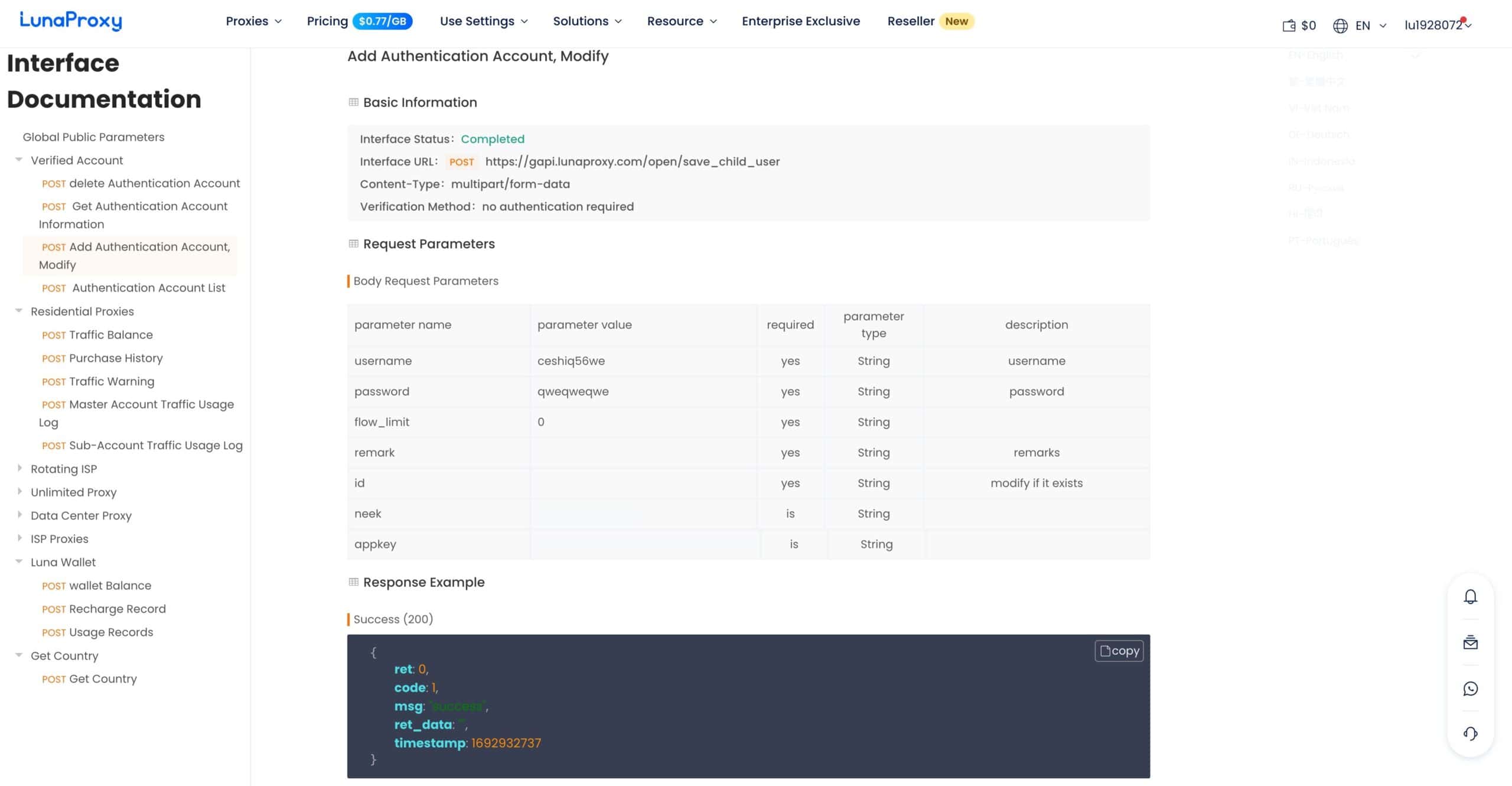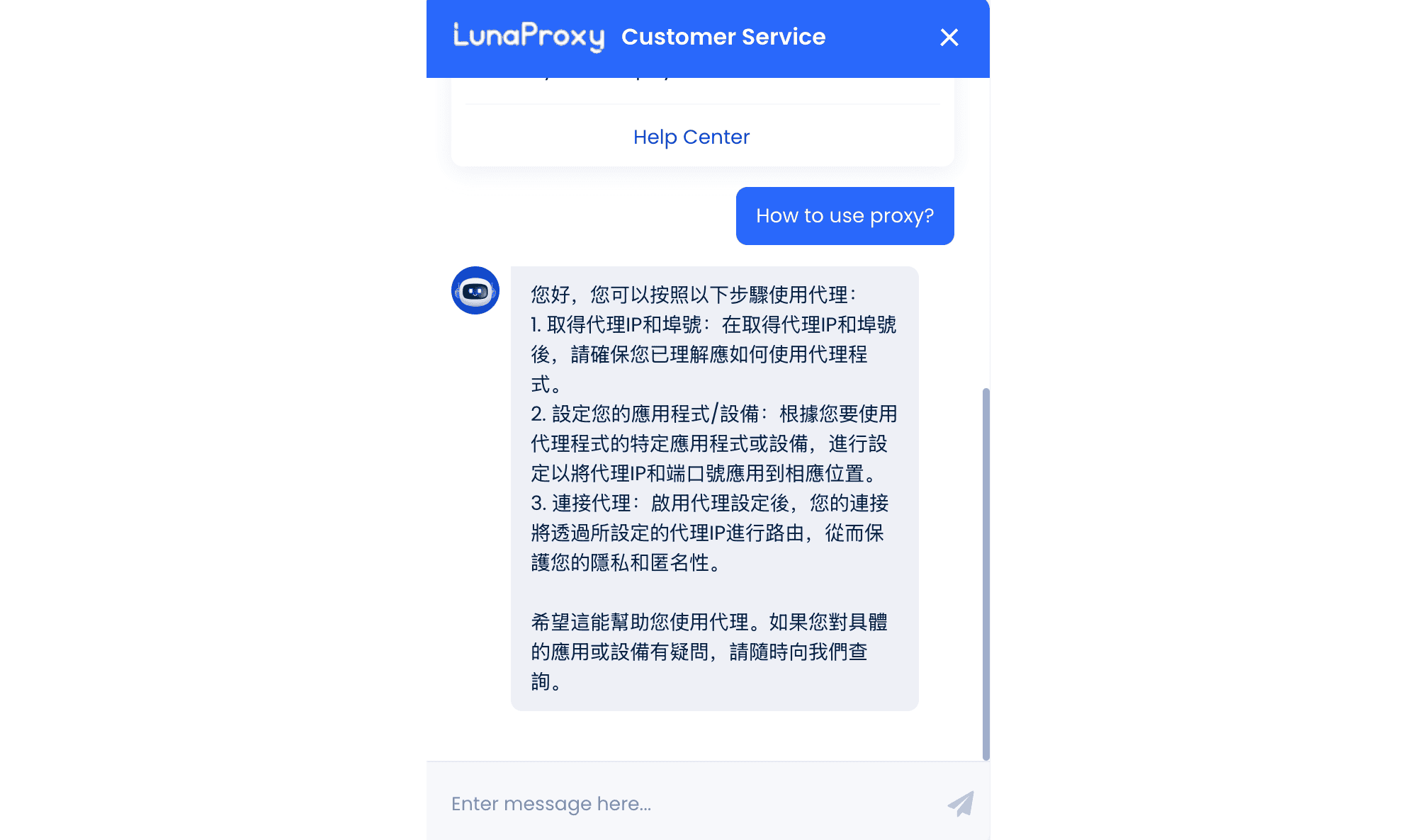LunaProxy Review
LunaProxy’s residential proxies are decent, affordable, and come in unconventional formats – but the user experience could be improved.
Use the code x to get y discount.
LunaProxy has a lot going for it. The provider’s residential proxies start from just $3.3/GB. They include a free (and optional) proxy manager app that looks and works much like 911 S5 did. And, you can get a residential plan without any traffic or connection limits, which is very hard to come by these days.
But where’s the catch? Is there a catch? That’s what we’re here to find out! For this review, we test LunaProxy’s metered and unlimited residential proxy networks. Here are our findings.
General Information
- Country: China (Hong Kong)
- Founded: 2022
- Proxy networks: datacenter, ISP, residential (/GB, unlimited)
- Web scrapers: –
- Supporting tools: Proxy manager (Windows & Linux), Chrome extension
- Price segment: Cheap
- Starting price: $2.5
- Payment methods: Credit card, PayPal, AliPay, cryptocurrencies, Google Pay, Apple Pay, more
- Trial: 1 GB for companies
LunaProxy comes from the family of six or more Hong Kong-located proxy providers that appeared between 2022 and 2024. They all share similar characteristics: attractive rates, constant discounts, and an S5 app, which emulates the infamous provider that made headlines in 2024.
LunaProxy, however, is somewhat different – the company positions as a proxy network for scraping, crawling, and similar tasks. It also has marketing figured out pretty well: you’ll often find it in Google ads and mentioned by third party tools. As a result – at least for us – LunaProxy is one of the poster boys to come from the Far East.
That said, we don’t know much about who stands behind LunaProxy. In addition, there’s little information explaining how the company acquires IPs. It does have an SDK, so we can assume that’s the main source. Still, we couldn’t find a KYC process or usage policies.
All in all, LunaProxy runs the commercial side of the business very well. But it still has things to improve on when it comes to legitimacy and brand building.
News about LunaProxy
-
By Adam Dubois
-
By Adam Dubois
- Conferences
-
 By
Dominic Li
By
Dominic Li
- Opinion Pieces
LunaProxy Proxy Networks
Lunaproxy offers access to three proxy networks:
- Residential proxies that give you a big pool of IPs from around 80 countries. You can pay for traffic or buy unlimited access.
- Datacenter proxies from 7+ countries dedicated to your exclusive use.
- ISP proxies from 20+ locations in dedicated or pool-based formats.
We tested Lunaproxy’s metered and unlimited residential proxy products.
LunaProxy’s traffic-based residential proxies are best suited for web scraping and similar tasks, when you need access to a large number of IPs. This product should include higher quality proxies than the unlimited pool, which has much potential for abuse.
The unlimited residential proxies are true to their name – a subscription gives you access to the full proxy network, without any traffic, port, or thread limits. LunaProxy told us that it even assigns a dedicated server to each customer. This product is great if you plan to use a lot of data fast.
It’s interesting that you can also access the metered pool through LunaProxy’s downloadable manager application. We cover it in the section on user experience.
Specifications
| Metered | Unlimited | |
| Advertised pool size | 200 million | |
| Locations | ~80 | ~50 |
| Targeting | Global, country, state, city, ISP, ZIP* | Global, country, state, city |
| Rotation | Every request, 1-90 mins | |
| Traffic | Plan based | Unlimited |
| Concurrency | Unlimited | |
| Protocols | HTTP(S) over SOCKS5 | |
| Other | Domain blocking | |
* Only using LunaProxy’s proxy manager.
LunaProxy advertises that it controls 200 million residential proxies. The number is most definitely exaggerated, no matter how you measure.
What’s interesting is that LunaProxy’s dashboard shows only around 80 locations for the metered residentials, missing most of Africa, some European countries like Serbia, and more. The unlimited product offers even less choice, omitting even the most desirable countries like Australia, United Kingdom, or the US.
Both services offer a wide range of targeting options, including cities, and in the case of traffic-based residentials – ASNs. However, you can’t freely combine a state/city and ASN: the choice is one or the other.
LunaProxy allows rotating proxies with every connection request, and it’s also possible to establish sticky sessions. You can freely choose a duration between one and 90 minutes.
It’s nice that you can block particular domains from accessing with proxies. This potentially helps to save traffic.
Integration & Use
- Connection method: Gateway address
- Authentication: Credentials, IP whitelisting
- Connection format
- Credentials:
USERNAME-region-us-st-newyork-city-newyorkcity-sessid-ID-sesstime-TIME:[email protected]:12233 - IP whitelisting: 43.159.29.44:20401
- Proxy manager: 127.0.0.1:60000, 127.0.0.1:60001….
- Credentials:
LunaProxy uses gateway addresses to connect you to residential devices. The provider has load balancers in different regions, which slightly changes the proxy address: na.lunaproxy for the US, as.lunaproxy for India, and so on. These changes are made automatically by the setup widget on the dashboard.
You can authenticate both with credentials (username:password) or whitelisting your IP address. The former method adds parameters to the username when you filter the pool or create sessions; the latter method generates new ports for different proxies.
Finally, you can use the metered residential proxies with LunaProxy’s desktop app. This creates a new hostname and binds the IPs you manually select to different ports. Authentication isn’t needed, as long as the manager is on your device.
Pricing Plans
| Metered | Unlimited | |
| Model | Subscription (30, 60, 90 days) | Subscription (1, 7, 30 days) |
| Format | Pay for traffic | Pay for access |
| Modifiers | ❌ | ❌ |
| Starting price | $16.5 for 5 GB ($3.3/GB) | $130 for one day |
| Trial | 1 GB for companies | ❌ |
You can access LunaProxy’s residential proxies after getting a subscription. Metered plans last a month by default, but there’s an option to extend the duration to 60 or 90 days. The price difference isn’t big: around 10% and 20%, respectively.
It’s interesting that traffic rolls over as long as you buy a new plan before the old one expires. This plan doesn’t have to be for the same amount – even the smallest package will do the trick.
LunaProxy’s unmetered plans can be bought for as little as one day. It’s hard to put them into context, as very few companies nowadays offer unlimited residential proxies.
The provider’s rates for the metered plans, on the other hand, will be several times cheaper than most competitors up until terabytes of data. Even if you choose to extend a plan, the difference will remain significant.
Performance Benchmarks
We last tested LunaProxy’s residential proxies in November 2024.
We were only given seven days to test the unlimited pool, so we made more requests to compensate.
#1: Pool size & composition
| Gateway | Requests | Unique IPs | Residential %* |
| Global | 1.2M over 21 days | 573,013 | 95.72% |
| US | 560k over 14 days | 163,750 | 94.54% |
| UK | 560k over 14 days | 42,338 | 87.76% |
| EU** | 1.2M over 14 days | 232,760 | 94.53% |
| Brazil | 560k over 14 days | 423,593 | 96.02% |
| India | 560k over 14 days | 324,151 | 96.39% |
| Australia | 140k over 7 days | 12,670 | 97.10% |
* IP2Location database, Usage type data point, (ISP, ISP/MOB, MOB IPs)
** Combines Germany, France, Spain, Italy, the Netherlands.
LunaProxy’s proxy network was big and predominantly residential. We found especially many proxies from Brazil and India, while the US and European pools looked more modest.
#2: Infrastructure performance
- Requests: Same as the pool test
- Target: Nearest server of a global CDN (<10 KB)
| Gateway | Our server location | Avg. success rate | Avg. response time |
| Global | Germany | 96.29% | 2.36 s |
| US | US | 98.45% | 1.10 s |
| UK | Germany | 98.32% | 0.86 s |
| EU | Germany | 97.89% | 1.12 s |
| Brazil | US | 98.67% | 1.75 s |
| India | Singapore | 97.40% | 1.16 s |
| Australia | Singapore | 97.80% | 1.96 s |
LunaProxy’s results were decent on their own: better in individual country pools and slightly worse when using proxies from all locations. Compared to the competition, however, they were several times slower to respond than the top options and failed more.
#1: Pool size & composition
| Gateway | Requests | Unique IPs | Residential %* |
| Global | 1.9M over 7 days | 1,167,091 | 96.33% |
| Brazil | 1.9M over 7 days | 825,446 | 95.16% |
| Spain | 1.9M over 7 days | 1,821 | 90.17% |
| India | 1.9M over 7 days | 2,780 | 91.51% |
* IP2Location database, Usage type data point, (ISP, ISP/MOB, MOB IPs)
LunaProxy’s unlimited residential pool was huge – but only in some locations. The obvious example is Brazil, where we found over 800,000 unique IPs. It was also the main IP source in the global pool. All in all, this proxy network is dominated by Tier 2 and 3 locations.
Note that we tested fewer gateways here than in the metered pool benchmarks. That’s because LunaProxy didn’t have endpoints for them.
#2: Infrastructure performance
- Requests: Same as the pool test
- Target: Nearest server of a global CDN (<10 KB)
| Gateway | Our server location | Avg. success rate | Avg. response time |
| Global | Germany | 98.07% | 1.59 s |
| Brazil | US | 98.30% | 1.17 s |
| Spain | Germany | 91.50% | 1.69 s |
| India | Singapore | 98.03% | 2.53 s |
For an unmetered network, LunaProxy performed really well. We experienced few connection errors; and while not super fast by industry standards, the response time sometimes even beat LunaProxy’s traffic-based product.
How to Use LunaProxy
Registration
To register with LunaProxy, you need to enter an email address and a password. It isn’t even necessary to confirm the email, though the provider recommends it. Alternatively, you can use a Gmail or Apple account.
For some bizarre reason, LunaProxy refuses passwords with special symbols, or anything that exceeds 16 characters. Good luck using a password manager.
There doesn’t seem to be a KYC process at this time.
Dashboard
LunaProxy has a dashboard where you can control your interaction with the service: buy proxies, set them up using provided widgets, get LunaProxy’s manager, track usage, download invoices, and more.
The dashboard is available in eight languages, including Russian, German, Portuguese, Chinese (naturally), and more.
Each product has its own tab, where you’ll be doing most of the interactions. The main page shows an overview with remaining balance, duration, and traffic use information.
The dashboard is less convenient for laptop users or displays with smaller resolutions – on our computer, one third of it simply failed to fit.
LunaProxy’s dashboard includes wallet functionality, which makes transactions easier to manage. There are many payment gateways to choose from: you can pay with a card, cryptocurrency, through PayPal, AliPay, and more.
Once you buy a plan, LunaProxy generates an invoice. The Billing page shows additional information about the transaction, including its date, units bought, and the payment method.
LunaProxy has a widget for configuring residential proxies. It works like most similar tools: you choose an authentication method, location, rotation parameters, and generate a list of proxy gateways. In this case, you also get code samples in 10 programming languages. All in all, the widget is useful and simple to use.
When using whitelisted IP authentication, the better way to set up LunaProxy’s residential proxies is through a separate dashboard tool called proxy manager (don’t confuse it with the desktop app). It removes the widget’s limitations of only country-level targeting and fixed session duration. It also lets you rotate proxies at will.
If you’re running multiple projects or want to share access with others, LunaProxy offers 500 IP whitelist slots. In addition, you can create sub-users, with the ability to name them and assign traffic limits. The only thing that’s missing is permissioned team access to the dashboard itself.
For residential proxies, LunaProxy’s usage statistics only show traffic consumption. You can select any time frame within the last 30 days. More granular data points like domains accessed, requests made, or countries used were missing when we wrote this review.
The provider has no network status page for showing the service’s uptime.
LunaProxy's Proxy Manager
LunaProxy also has a free desktop application as an alternative way to work with proxies. It’s available for Windows and Linux.
The app strongly resembles the legendary but now closed 911 S5: you get a huge list of IPs with precise filters to pick out the proxies you need. You then connect to those devices directly. There’s an option to build a list of favorite IPs and set up the proxies with other applications (such as web browsers) through the manager.
What’s interesting is that LunaProxy doesn’t require getting a separate plan (which are often priced by accessed IPs) – you can use its proxy manager with a regular subscription. This is a strong value add for use cases like account management which require more careful proxy selection.
API Access
LunaProxy offers a public API for working with its proxies. Its features include the following:
- Creating, modifying, adding limits to, and deleting sub-users.
- Getting the purchase history and wallet balance.
- Monitoring the traffic use of the main account and sub-users.
- Fetching the list of available countries.
The API documentation lists available parameters for each endpoint, together with example responses. However, it doesn’t give any further explanations, so you’ll have to work things out by yourself.
Documentation
LunaProxy has a documentation hub that explains how to use its products. The hub includes sections for each product, as well as a general FAQ for product and billing questions.
It’s detailed enough to answer most questions, though integration tutorials with third-party tools lack popular web scraping libraries, such as Puppeteer. The hub can feel messy at times, but LunaProxy does a relatively good job at curating it compared to some other Chinese providers.
There are also video guides – though the narrator has a thick Chinese accent, this doesn’t prevent from understanding the content.
Hands-On Support
LunaProxy claims to have 24/7 live support available in any time zone. In reality, the live support is a chat bot. In November 2024, the experience was messy, to say the least: the robot answered some questions in Chinese and broke down as soon as we strayed away from the prompts.
Alternatively, you can reach the provider through email. You’ll receive replies within 24 hours. This is better than the robot (frankly, anything is) but still far from ideal.
Conclusion
Like we wrote in the beginning, LunaProxy has a lot to offer. Aside from the usual pay-money-get-access arrangement, there are many value adds: the proxy manager app, the rolling over traffic, and of course, the unlimited access plans. The price is right, too.
It’s not all rainbows, though. LunaProxy’s residential network is neither the biggest (unless you need IPs in South America), nor the best performing. The user experience is lacking at times. And we could use more reassurance that the proxies we’re using opted in willingly and aren’t abused.
All things considered, LunaProxy proves that it’s one of the best known Chinese proxy providers for a reason.
LunaProxy Alternatives

Dataimpulse can be a good alternative if you’re looking for affordable proxies. Its traffic never expires, which is a bonus.

Bright Data offers more IPs, better performance, and a similarly powerful proxy manager app. It’s much more expensive, though.

PIA S5 is extremely similar to LunaProxy in all but a few aspects. Some may find its pay-per-IP residential proxy plans more convenient.
Recommended for:
Those who need affordable residential proxies or unlimited access.
